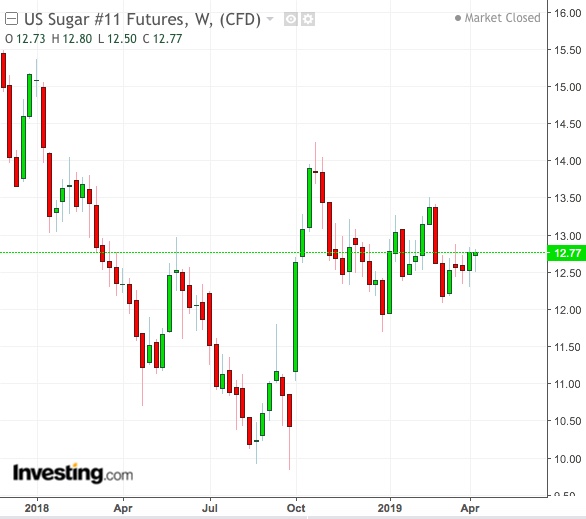Mother Nature has joined oil in adding to sugar prices.
Drought in the world’s second largest sugar grower, India—with output from the Maharashtra state, which houses India’s iconic commercial capital Bombay and film city Bollywood, on track to hit a three-year lows due to dry weather—has brightened the outlook for the sweetener’s prices after a supply squeeze caused by top producer Brazil’s allocation of more of its cane crop to ethanol-making, due to the rally in oil.
The South American country has a 27% mandate for ethanol in its gasoline—far higher than the 10% imposed on most U.S. motor fuels. That has traditionally prompted local sugarcane growers to focus more on the energy industry than food for their market, a strategy paying dividends with this year’s powerful rise in crude oil.
Less than 39% of the cane crush in Brazil would be dedicated to sugar-making as ethanol continues to pry away production, Platts, the business newswire of S&P Global (NYSE:SPGI), reported last month.

Both factors have colluded to make raw sugar this year's top performer among the so-called soft commodity markets. New York-traded sugar futures have a year-to-date gain of more than 6%, versus the rise of less than 1% in cocoa and declines of nearly 8% in coffee and 13% in orange juice.
In the previous two years, New York sugar futures tumbled almost 40% from supply gluts.
At Tuesday’s settlement of 12.77 cents a lb, benchmark May sugar futures on New York’s ICE (NYSE:ICE) Futures were still rated a “Strong Buy” by technical analysts on Investing.com. The contract was also pegged with a top-end resistance of 13 cents. If it got to that level, it may have a chance to reprise the 2019 high of 13.50 cents hit on Feb. 17.
Bloomberg reported that prolonged dry weather in India’s Maharashtra was affecting the state’s sugar cane planting, and production may drop 25% from a year ago to reach just 8 million tons in the year staring on Oct. 1. That would be the biggest fall since 2016-17, when production almost halved.
The forecast comes as private Indian forecaster Skymet Weather Services predicts a drier-than-normal monsoon for the country this year, potentially shriveling crops and cutting plantings. That may offer relief for producers such as Australia and Brazil, which have complained to the World Trade Organization that India’s gushing exports and subsidies are suppressing global prices.
Despite the supportive technicals as well as fundamentals over India and Brazil, some analysts like Jack Scoville of the Price Futures Group in Chicago urged caution against buying into the sugar rush.
“The fundamentals still suggest big supplies and ideas of big production in Asia also help keep any rallies in check,” Scoville said, citing higher Thai and Pakistani output, among others.
But he acknowledged that Brazil has been using a larger part of its sugarcane harvest to produce ethanol instead of sugar, and weather in the top producing country has turned unsuitably drier.
Brazil’s sugar-ethanol ratio for cane averaged 44:56 over the past five years.
But this year’s oil rally, which boosted U.S. West Texas Intermediate crude by 41% and global benchmark Brent by 31%, has tilted the balance even further toward ethanol.
Platts said Brazilian ethanol prices have maintained a wide premium to domestic sugar quotes, attracting more cane crush for that purpose. Brazil’s higher-than-expected fuel consumption, in turn, was fueling even more ethanol production.
Which stock should you buy in your very next trade?
AI computing powers are changing the stock market. Investing.com's ProPicks AI includes 6 winning stock portfolios chosen by our advanced AI. In 2024 alone, ProPicks AI identified 2 stocks that surged over 150%, 4 additional stocks that leaped over 30%, and 3 more that climbed over 25%. Which stock will be the next to soar?
Unlock ProPicks AI